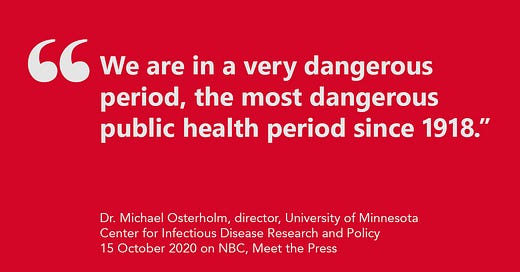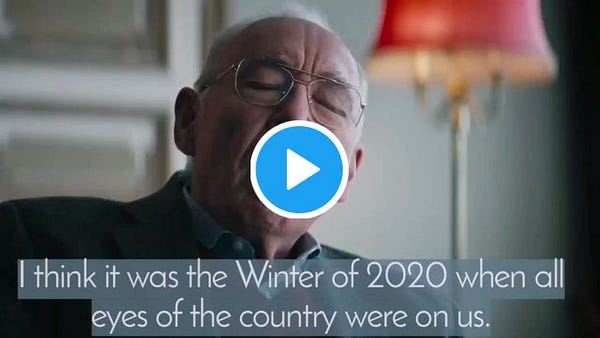COVID-19 day 302: 📈 Escalating cases suggest a jump in deaths beginning Black Friday : 16 November 2020
On Sunday, the US passed 11 million cases; six successive days set record daily hospitalizations; El Paso is using temporary morgues; two RNs speak out, one from Texas, the other from South Dakota
Sunday was day 301 since the first case of coronavirus disease was announced in the United States, and it marked the day we passed 11 million cases. We are experiencing an “unprecedented surge of hospitalizations.” Sunday’s report, 69,864, marked the sixth successive day with new hospitalization records. Yes, more than in the initial spike (first peak, 59,940 on 15 April 2020) with far more states affected.
The steady rise in hospitalizations follows the steady rise in cases.
Regardless of which tool you check - CDC, Covid Tracking Project or Johns Hopkins - we had more than 1,000,000 new cases in the seven-day period ending Sunday 15 November. The CDC and Johns Hopkins reported more than 1 million on Saturday 14 November. Johns Hopkins data exceeded 1 million on Friday 13 November.
The numbers are so large as to be both scary and unfathomable. If you feel numb, you are not alone.
About the quote: Dr. Michael Osterholm is an advisor to Biden-Harris on COVID-19. He said many Americans have “pandemic anger” and also many do not believe it is a real public health problem.
Sections (no jump links, sorry!)
1, One big thing; 2, Recommendations; 3, Politics, economics & COVID; 4, Key metrics;
5, Resources
⓵ One big thing: what escalating case rates mean
We will witness 2,000 - 3,000 COVID-19 deaths per day for the 10-day period after Black Friday (28 November - 07 December 2020) based on the 1,418,442 positive cases reported from 05-14 November. To date, the most reported deaths was 2,692 on 29 April 2020.
There’s about a 12-day lag between an increase in reported cases and a commensurate increase in hospitalizations. I know you know there’s a lag. Bear with me.


ICU admissions lag hospitalizations. Tulsa, Oklahoma, ran out out of ICU beds on Veteran’s Day.
Eight states have an upper limit estimate of ICU capacity equal to or exceeding 95% (95% confidence, 14 November 2020 US government data):
Idaho, Kansas, Maine, Missouri, Nevada, North Carolina, North Dakota, and Texas
Another five have an upper limit estimate of ICU capacity equal to or exceeding 90%:
Delaware, Hawaii, Maryland, New Mexico and Oklahoma
Deaths lag ICU admissions. Trevor Bedford, Fred Hutchison Research Center and the University of Washington, has calculated the lag from case-to-death at about 22 days.


How many people die, as a percentage of people we know have the disease, is the case fatality rate (CFR). The US average is 2.2%; compare that to Mexico (9.8%), the UK (3.8%), Spain (2.8%), South Korea (1.7%) and New Zealand (1.2%).
Note: our deaths per capita (75.26) are among the worst in the world (we’re 13th and only three of the top 13 are European).
Bedford calls his calculation a lag-adjusted CFR, and it’s been about 1.8% since August. To some extent this is because we are testing more people. But we also know more about the disease and have developed treatment methods. Hospitals have not been so pressed that they had to rely on refrigerated trucks as temporary morgues.
Right now, El Paso, Texas, has temporary morgues. And county inmates have been pressed into labor to relieve that strain.
On 03 November, Johns Hopkins reported 91,553 cases. Assuming that 1.8% holds in our current scenario, on Thanksgiving Day, approximately 1,648 people will die of COVID-19. Black Friday: about 1,851 deaths (04 Nov 2020, 102,831 cases).
On 13 November, Johns Hopkins reported a record 184,514 cases.
On 06 December, about 3,300 people will die of COVID-19 if this 1.8% CFR holds. Bedford calls these deaths “baked in.” It’s possible the CFR it will go up again due to stressed health care facilities.
Here are the data and projections for the opening paragraph:
05 Nov 2020, cases: 121,888; deaths: 2,194 (28 Nov 2020)
06 Nov 2020, cases: 126,480; deaths: 2,277 (29 Nov 2020)
07 Nov 2020, cases: 126,742; deaths: 2,281 (30 Nov 2020)
08 Nov 2020, cases: 107,597; deaths: 1,937 (01 Dec 2020)
09 Nov 2020, cases: 142,922; deaths: 2,573 (02 Dec 2020)
10 Nov 2020, cases: 141,052; deaths: 2,539 (03 Dec 2020)
11 Nov 2020, cases: 148,098; deaths: 2,666 (04 Dec 2020)
12 Nov 2020, cases: 152,594; deaths: 2,747 (05 Dec 2020)
13 Nov 2020, cases: 184,514; deaths: 3,321 (06 Dec 2020)
14 Nov 2020, cases: 166,555; deaths: 2,998 (07 Dec 2020)
NOTE: To see the relationship between reported deaths and cases, the two Y axes are on different scales.
⓶ Recommendations
🤓 Recommended reading
▪️ No introduction can do justice to this personal essay.
My grandfather died from complications of COVID-19. The last time I saw him, I wore gloves and a plastic gown, and put a face shield on over a mask. I stood next to his hospital bed with my family. The doctor warned us not to touch him, but I did, gently, one gloved hand over his. That he should die without touch felt intolerable, a punishment for a man who didn’t deserve one…
My grandfather’s name was Charles Tibbetts. Although he lived in Virginia, he would want you to know he was not from the South. He was from Maine and crossed the Mason-Dixon Line only because my grandmother had died and he wanted to live near his only child, my mother.
Who Dies. COVID took my grandfather. But it wasn’t what killed him. The Cut, 09 November 2020.
▪️ Utah has quadrupled its summer spike, now reporting 2,500 confirmed cases of COVID-19 a day. Nathan Hatton, a pulmonary specialist at the University of Utah Hospital: “There are times I’ll come in in the morning, see patients, work that night, work all the next day, and then go home.”
Some health-care workers told me that COVID-19 patients are the sickest people they’ve ever cared for: They require twice as much attention as a typical intensive-care-unit patient, for three times the normal length of stay. “It was doable over the summer, but now it’s just too much,” says Whitney Neville, a nurse based in Iowa. “Last Monday we had 25 patients waiting in the emergency department. They had been admitted but there was no one to take care of them.” I asked her how much slack the system has left. “There is none,” she said.
‘No One Is Listening to Us’. More people than ever are hospitalized with COVID-19. Health-care workers can’t go on like this. The Atlantic, 11 November 2020.
⓷ Politics, economics and COVID-19
🦠 Midwestern state governors are beginning to reverse course. Republican governors in Iowa, North Dakota, Ohio, Utah and West Virginia have issued mask mandates. Michigan has a three-week “epidemic order” that targets “indoor social gatherings,” limiting them to two households. High schools are also closed, as are entertainment centers like bowling alleys and movie theaters.
🆘 El Paso, Texas, should be leading the news every day. But it’s not. It’s a border town with about 700,000 people. I’ve already told you about inmates moving corpses to temporary morgues. Here’s the first of two stories from RNs on working the COVID-19 ward. Read it on ThreadReader.

Osterholm: “People don’t want to hear that El Paso isn’t an isolated event. El Paso, in many instances, will become the norm.”
🆘 And the second, from South Dakota. Read it on ThreadReader.

‼️ And yet. A survey of 2,000 Americans conducted by the Ohio State University Wexner Medical Center between 19 October 29 and 02 November found that 38% planned to have Thanksgiving dinner with more than 10 close family members. One-third of those will not require masks.
In contract, the governors of California, Oregon and Washington issued a joint quarantine statement regarding inter-state travel and asked citizens to “stay local.” And Washington has also ordered restrictions on indoor gatherings.
✅ This German government Covid PSA (subtitled for those of us who do not know German) is THE BEST!
⓸ Key metrics
🦠 Friday, Johns Hopkins reported 10,737,335 (184,514 new) cases and 244,332 (1,909 new) deaths, an increase of 1.75% and 0.79%, respectively, since Thursday. A week ago, the daily numbers increased by 1.32% and 0.49%,, respectively.
Friday
- cases 🔺29% compared to seven-day average; deaths 🔺62%
- seven-day average: 🔺143,360 cases and 🔺1,180 deaths
- 2.28% cases leading to death
- 41.5 cases/100K (CDC)
- 1,003,519: cases last seven days (JH)One week ago
- cases 🔺28% compared to seven-day average; deaths 🔺26%
- seven-day average: 🔺98,509cases and 🔺912 deaths
- 2.43% cases leading to death
- 28.4: cases/100K (CDC)
- 689,561: cases last seven days (JH)
Note: the seven-day average is important because dailies vary due to factors other than actual case numbers, particularly over a weekend.
🇺🇸 13 November
CDC: 10,508,864 (194,610 new) cases & 242,216 (1,147 new) deaths
- One week ago: 9,581,770 (117,988 new) cases & 234,264 (1,135 new) deathsState data*: 10,602,920 (171,031 new) cases & 235,682 (1,237 new) deaths
- One week ago: 9,549,835 (127,314 new) cases & 227,016 (1,184 new) deaths
KS reports only M-W-F; CT and RI report only M-FWHO: 10,266,631 (142,076 new) cases & 240,044 (1,471 new) deaths
- One week ago: 9,387,978 (106,050 new) cases & 232,166 (1,132 new) deaths
🌎 13 November
Johns Hopkins interactive dashboard (11.00 pm Pacific)
Global: 53,320,714 (587,426 new) cases & 1,302,036 (8,853 new) deaths
- One week ago: 49,322,826 (642,724 new) cases & 1,242,868 (9,555 new) deaths
* Johns Hopkins data, ~11.00 pm Pacific.
State data include DC, Guam, the Northern Mariana Islands, Puerto Rico and the US Virgin Islands
The virus was not created in a lab and the weight of evidence is that it was not released intentionally. Although early reports tied the outbreak to a market in Wuhan, China, analyses of genomic data have suggested that the virusdeveloped elsewhere.
⓹ Resources
👓 See COVID-19 resource collection at WiredPen.
📝 Subscribe to Kathy’s COVID-19 Memo :: COVID-19 Memo archives
🦠 COVID-19 @ WiredPen.com
📊 Visualizations: US, World
🌐 Global news(at WiredPen)







